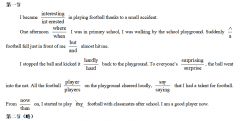2015华中师范大学第一附属中学高三期中考试英语试题及答案(4)
A.some backward races don’t have a language of their own
B.some races in history didn’t possess a language of their own
C.any human race, whether backward or not, has a language
D.some races on earth can communicate without a language
60. As the author says, people of underdeveloped cultures can have________languages.
A.complicated B.uncivilized C.primitive D.wellknown
61. American Indian languages are mentioned to prove that they are________.
A.as fully developed as some wellknown languages
B.more primitive than some wellknown languages
C.more complex than some wellknown languages
D.just as primitive as some wellknown languages
62. According to the author, language changes are most likely to appear in________.
A.grammar B.vocabulary C.intonation D.pronunciation
D
Sensing phantom phone vibrations(手机虚幻震动) is a strangely common experience. Around 80% of us have imagined a phone vibrating in our pockets when it’s actually completely still. Almost 30% of us have also heard non-existent ringing. Are these signs of madness caused by digital culture? Not at all. In fact, phantom vibrations and ringing indicate a fundamental principle in psychology.
Psychologists use a concept called Signal Detection Theory to guide their thinking about the problem of perceptual(感知的) judgments. Working through the example of phone vibrations, we can see how this theory explains why they are a common and unavoidable part of healthy mental function.
When your phone is in your pocket, the world is in one of two possible states the phone is either ringing or not. You also have two possible states of mind the judgment that the phone is ringing, or the judgment that it isn’t. Obviously you’d like to match these states in the correct way. True vibrations should go with “it’s ringing”, and no vibrations should go with “it’s not ringing”. Signal detection theory calls these faithful matches a “hit” and a “correct rejection”
But there are two other possible combinations you could mismatch true vibrations with “it’s not ringing” (a “miss”); or mismatch the absence of vibrations with “it’s ringing” (a “false alarm”). This second kind of mismatch is what’s going on when you imagine a phantom phone vibration.
What does that mean in terms of your phone? We can assume that people like to notice when their phone is ringing, and that most people hate missing a call. This means their perceptual systems have adjusted their bias(偏向) to a level that makes misses unlikely. The unavoidable cost is a raised likelihood of false alarms of phantom phone vibrations.
The trade-off between false alarms and misses also explains why we all have to put up with fire alarms going off when there isn’t a fire. It isn’t that the alarms are badly designed, but rather that they are very sensible to smoke and heat and biased to avoid missing a real fire at all costs. The outcome is a rise in the number of false alarms. These are inconvenient, but nowhere near as inconvenient as burning to death in your bed or office. The alarms are designed to err on the side of caution.
63. The writer tries to explain phantom phone vibrations .
A. by analyzing some facts B. by giving some examples
C. from the angle of biology D. from the angle of psychology
64. According to the writer, the sense of phantom phone vibration is .
A. strange and mad B. harmful but avoidable
C. common and unavoidable D. universal but unhealthy
65. When we judge correctly that “it’s not ringing”, this is called a “ ”.
A. hit B. miss C. false alarm D. correct rejection
66. What does the underlined part in the last paragraph mean?
A. Better late than never. B. Better safe than sorry.
C. Fight over the smallest things. D. He who makes no mistakes makes nothing.
E
Life can be difficult, particularly for adolescents. Many young people get through the troubled years of adolescence and emerge into adulthood reasonably safe and sound. Too many youngsters, however, feel confused and ignored. Unable to climb out of the dilemma, these youngsters are socially and emotionally “at-risk”. They may suffer from such painful symptoms as anxiety, depression or anger.
Many parents, in an honest attempt to help their adolescent from emotionally drowning, seek professional treatment. They put a great deal of faith in professional clinicians to find a way out for their child. However, many of these parents begin to recognize that solving the problem is more complex than they had initially realized. It has been my clinical experience that some parents who bring their resistant youngster for treatment see their child as being solely responsible for the problem. In many cases, the adolescent feels angry and defective for being pushed into treatment.
We can gain some insight if we look at things through the eyes of the adolescent. The child is usually reluctantly brought by the parents to clinicians as what I call the “identified patient”. The youngster waits anxiously as the parents lay out the problem with the clinicians with remarks such as, “I don’t know what’s happening to my child lately, but he’s not his old self. He doesn’t listen to me anymore, has been getting failing grades, acts out at school, and stays in his room all the time.’’ Such descriptions at the beginning of treatment by the parents may strengthen feelings of incompetence on the part of the child. Such a pattern at the beginning sets up an intention of resistance and leaves the potential for a positive outcome at risk.





